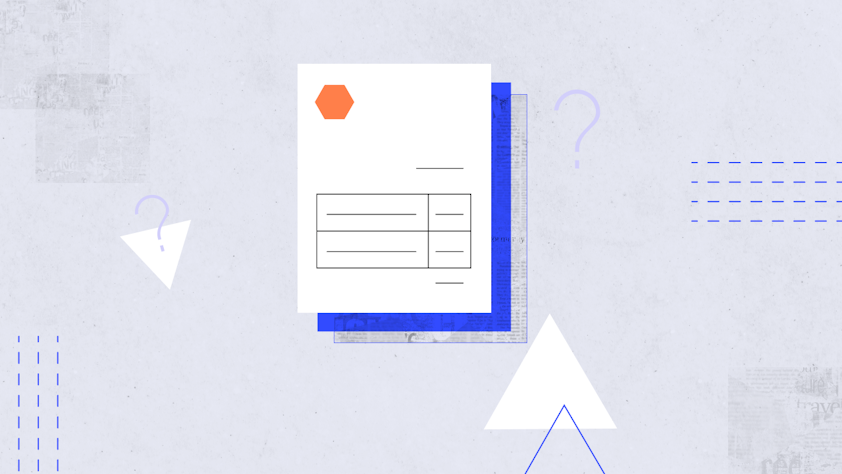
What is an invoice?
Invoicing goes back to the beginnings of human history. The earliest form of writing emerged because of the need to invoice and keep records of items bought and sold.
Therefore, from the dawn of written history to the emergence of modern digital invoicing in the 21st century, it seems you need to create a binding agreement in writing if you want to make sure you get paid for your work.
What is an invoice? How is it different from a bill or purchase order?
The Merriam-Webster dictionary defines an invoice as "an itemized list of goods shipped usually specifying the price and the terms of sale."
Essentially, an invoice is a document detailing the specifics of a business transaction between a buyer and seller. It includes the product or service to be provided and the price to be paid, often in conjunction with a purchase order.
Commercial invoices, pro forma invoices, bills, and receipts
There are a few fundamental ways an invoice differs from a bill or receipt. Here are the definitions you need to know:
- It's all about perspective. Both invoices and bills are written statements for money owed. However, invoices are often sent while bills are received. In other words, you send an invoice to your customer – and they receive a bill.
- It depends on context. For example, when you go to a restaurant, you are given a bill for your meal – and it's a given that you will pay before heading out. On the other hand, invoices tend to be more comprehensive and have set terms for reimbursement - days or weeks from the issue date.
- Commercial invoices have an invoice number that references the specific work done at a particular time. They often include a timesheet or show the progress of a project with milestone payments. No one would expect a restaurant chef to set down a detailed list of ingredients and a timesheet detailing the time it took to prepare your food. However, a contractor remodeling a home would likely work over several months, bill at set milestones, and have the customer pay for materials used.
- A pro forma invoice is an agreement between a buyer and seller to provide goods or services by a specified date and time. In contrast, sales invoices are for services that have been provided.
- A receipt is a written statement acknowledging that a good or service has been paid for.
Ready to start invoicing?
Getting started with the right invoice generator

At Invoice2go, a Bill.com company, it's our mission to amplify the independent spirit of small businesses worldwide. We make it easy to create professional invoices with our invoice templates and invoice generator.
Still, before you get started, it's best to understand what an invoice is, the purpose invoices serve, and how to create professional and complete documents. If you're starting as a service provider with a sole proprietorship or LLC – this is something you want to ensure you get right.
Why use invoices, and what is the invoicing process?
As a business owner, you'll find that invoices help you project a professional image and provide the information required to expedite payments from every customer. In addition, they enable you to stay organized and maintain steady cash flow by keeping all parties involved in the loop. This is why it's so important to get them right.
The importance of the date
As a small business owner, you know how critical it is to get paid promptly. The date you collect payment for your goods or services could spell the difference between keeping your business afloat and exceeding credit duration with lenders or suppliers.
Part of this relies on you sending invoices on time. Although you're probably more interested in focusing on the work you're passionate about - whether you're in the construction industry, content marketing, or you create chainsaw ice sculptures for corporate events - you can't let the administrative side of your business slip.
The benefit of invoicing software
Paper invoice documents can be messy and difficult to keep track of. In addition, using Word or a Google doc can also be time-consuming, and the results may not look great.
The best invoice templates make it easy to send invoices via email, messenger, or social media from a smartphone or tablet. That way, you can do it the moment the job is complete, rather than waiting until you can get to a computer to access accounting software. However, simply sending an invoice doesn't necessarily start the clock on your invoice term. You also need to include an invoice date.
The date you include provides the starting point for your payment term, whether it's 30 days, 60 days, or a time frame you've agreed upon with the customer. What if your email gets filtered as spam or your text message delivery is delayed?
When you list the date on the invoice, it won't matter. Your payment is due from that date only, not necessarily the date your customer claims to have received it.
The basics of a sales invoice
Static invoice templates or an interactive invoice generator can take the guesswork out of creating a professional invoice you can reuse. These electronic invoices offer a pre-formatted document layout with spaces for all the details, even for different types of invoices, so you don't have to deal with adding tables and line items.
When you're first starting your business, you want to look professional, set payment expectations, and do all you can to secure needed compensation on time and in full. This starts with knowing how to craft and proofread complete invoices.
Creating invoices for sales transactions
So, what information should be on every sales or timesheet invoice? Each invoice you generate should include your business and customer information, as well as a detailed account of the work completed. Invoicing software can help you quickly and painlessly fill out this information.
Many companies also like to include a company logo to brand their invoices and appear more professional. You might want to add a short, personal message thanking each customer for their business and encourage them to continue ordering regularly.
Invoice numbers 101
Sequential invoice numbers can help you stay organized for record-keeping, and they can help every customer organize their records. These numbers allow you to track accounts receivable, and clients track accounts payable. However, there is another fundamental reason to use invoice numbers that you might not realize.
They could be significant in the case of an IRS audit. For example, if your invoice numbers aren't in order, the IRS may take it as a sign that you're committing a type of fraud like misreporting income. Be sure to talk to a professional for additional tax advice for your small business.
Keep your documents for services provided organized
With proper bookkeeping, your financial statements will clearly show sequential invoice numbers corresponding with payments from customers, acting as proof of earnings listed in your income tax filing. This, in turn, can help you to stave off added interest, fees, and other penalties.
Creating invoice numbers doesn't have to be complicated. Each time you generate a new invoice, assign a number higher than your last one.
You can increase the invoice number by one, ten, or a hundred if you choose. However, typically, just adding one is sufficient and prevents confusion in the event of an audit. In addition, you don't have to create different number ranges for other customers or make your system overly complex.
If you sent invoice number 1001623 to Client A last week and completed a job for Client B this week, number the new invoice as 1001624. You can reuse or put in new information (customer name, work completed, total costs, and even invoice term), but make sure you NEVER use the same invoice number twice.
Setting payment terms

Whether you're working with a shoestring budget or relying on steady cash flow to keep the doors open, you need to get paid quickly. This starts with using a convenient invoice app that allows you to send invoices on the spot, anytime and anywhere.
Getting your business paid on time is what keeps your operation running. In addition to having the right tools for invoicing, you need to carefully examine how the term invoice is set.
What is a payment term?
First, you should know that your invoice payment terms define when you expect to receive compensation for work completed, starting with the date listed on your invoice. One of the most common payment terms is net 30 (N/30), which means payment is due in full no later than 30 days from the date on your invoice.
If your invoice is dated June 1 and your invoice term is net 30, payment is due by June 30. Naturally, your customers can submit early payment or partial payments leading up to the due date, but the term you select is meant to discourage paying at a later date.
Setting terms with your clients
Other standard payment terms include net 60 and net 90. Some vendors list their payment terms as "due on receipt," which means immediate payment is expected immediately. Why would you choose one payment term over another?
Benefits of different invoice terms
Many small businesses prefer net 30 because it sets a relatively brief time frame for payment. At the same time, it avoids placing unrealistic expectations on customers to rush the payment process (and it is a process that can involve multiple people and departments at the corporate level).
Plus, you have a chance to chase down late payments before they start to impact your cash flow. It's also ideal for recurring invoices if you do regular work for the same customer weekly or monthly.
You may choose to set a longer-term for the benefit of a customer if, say, they need flexibility with their cash flow, and you don't need immediate funds to maintain your business health. Of course, they can always submit early if they're able.
Finding what types of invoices work best for you
While some businesses prefer to stick with a set payment term for all customers, others are willing to negotiate on a case-by-case basis. You'll simply have to decide what makes sense for your business and your clientele.
With a free and simple invoice generator from Invoice2go, you'll have no trouble creating professional, complete invoices anywhere and anytime, so you can get paid quickly.
Check out why small businesses everywhere rely on Invoice2go for easy and comprehensive invoice software.
Invoice FAQs
An invoice is a document that details the specifics of a business transaction. It tells customers about payment requirements for the product or service provided. It typically includes itemized billing, the total amount due, and information like an invoice number, invoice date, and payment terms.
Invoicing is intended to notify a customer that goods have been delivered or services have been performed, and payment is now due to close out the sales process. Invoices help you organize your finances, track and manage payment schedules, and maintain records for tax purposes.
All invoices are bills, but not all bills are invoices. While a bill can be a generic request for payment, an invoice includes much more specific information, such as:
- Your name and business contact information
- Client name and contact information
- Invoice date
- Terms of payment
- Invoice number
- A detailed accounting of work completed or goods delivered and cost
- Additional expenses (applicable taxable amount, shipping and handling, etc.)
- Total amount due
Here is an article that goes into more detail about the differences between a bill vs invoice.
No. Whereas an invoice is an accounting of goods delivered or services rendered, along with a payment request, a receipt shows that a payment has been made. Here is an article that goes into detail about whether an invoice is a receipt.